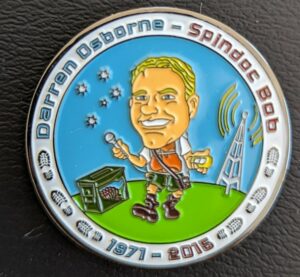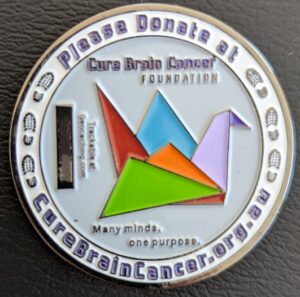The Birth of Geocaching
The US Government flicked the “big switch” in May 2000 that allowed non-military access of their satellite network. This led technology enthusiasts to think “what could we do with this access” and on May 3rd 2000, Dave Ulmer created the first gps-stash and wrote on a forum the specific coordinates and wanted to see who would have a go at finding it.
Sure enough, within 3 days the gps-stash was found twice. A can of beans, part of the original stash, is considered the first travelbug. The “Original Can of Beans” or OCB is guarded by Team 360 and can be discovered on the road or at events.
At the location of the very first geocache, a memorial plaque has been placed.
The idea continued to develop via forums and eventually Jeremy Irish started up the website geocaching.com. This was the only way to access location information and people would print out information about a geocache and go with the rough instructions they could piece together at home and on site. Personal GPS enabled devices were becoming available, although the cost of entry into this new technological world was still quite high. This meant that the average player in the early-2000s was a person who was already and outdoors type (bushwalkers, hikers, campers) and had the means to purchase the latest technology. The game remained low key and very “secret squirrel” and you couldn’t be an accidental geocacher – you needed to be doing it on purpose.


Geocaching comes to Australia
The first geocache was placed in Australia on 18th May 2000 in Lane Cove National Park by kerravon (Paul Edwards) called Lane Cove (GC3E). It was a white bucket with a lid buried in the ground. [1]
It only took a year for National Parks and Wildlife Service to remove this first geocache [2]. A ranger found it and it happened to be placed in an area that was home to protected flora (Darwinia Biflora). As a result of this, the NPWS issued a blanket ban on the placement of geocaches in ALL NSW national parks.
It was as a result of this ban, in around 2008, that a small group was spurred on to do something about this position. The group was The Spindoctors (specifically Spindoc Bob), Team Webguy and Damo. and their goal was to create an authority that could negotiate on behalf of its members. The group met to create a Memorandum of Understanding (MoU) showing that geocaching would be beneficial to national parks and that the group could work with rangers in the best interests of the parks and the game.
The original plan was for the MoU to stand for five-years as a trial and then it would be assessed for impact. NPWS would select the caches that they would be watching during the trial but the group were not told which ones they would be. Any geocache placed in a National Park after 2009 would need to gain approval before a geocaching.com reviewer would publish it.
Geocaching NSW starts to advocate for the game
The original committee first sat in 2008 with Geocaching NSW Inc. associated in 2009. It took until 2011 for negotiations with NPWS to finally approve the MoU. This agreement remains in place to this day.
In the early years of the association, Spindoc Bob’s existing media profile (he was a science communicator for the ABC) allowed him to speak about geocaching to many people as it was very much novel back then. Geocaching NSW started to hold regular events, education sessions and empowered the community to hide quality geocaches and be responsible geocachers when finding. Spindoc Bob’s Geotalk podcasts (both audio and video) helped in promoting the game in the NSW community.
The committee saw a wide variety of geocachers joining to help the community. Some stayed for one term, some stayed for many years. The first president Spindoc Bob stepped down from the role in 2012 and sadly passed away in 2015 due to brain cancer. In honour of his contribution to the association, a limited edition commemorative geocoin was created to help raise funds for the Cure Brain Cancer Foundation.


Moving into the Future
With changes in technology, specifically the ability to have GPS functionality built into smartphones, the tools for geocaching were now in everyone’s hands. All you need is a smartphone with GPS capability, a geocaching app, an account on Geocaching.com and a pen to get started.
The popular Geocache of the Year award is decided on each year and the winner is announced at the annual Christmas party. This program highlights the most creative geocaches, the best locations, and the awesome experiences that geocaching takes you to in New South Wales.
Geocaching NSW continues to offer education opportunities, social gatherings and the chance to get outside your normal geocaching boundaries with expeditions to unique locations within NSW. In 2025 Geocaching NSW in conjunction with the OzMega Geocaching Committee are bringing the first mega to Sydney. We are proud to finally make this a reality and bring to life one of Spindoc Bob’s wishes for the association.
Footnote
- Once geocaching started to grow, geocaching.com decreed that no geocaches were to be buried as this would damage the environment. Read more about the guidelines for placing geocaches.
- The once physical cache has been turned into a Virtual Cache and although it goes close to the original area, it no longer takes you to the area of protected flora.
